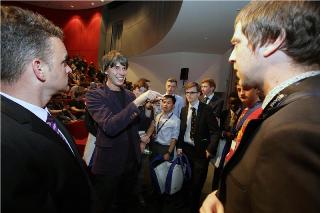Jul 6 2015
Online presentations from renowned scientists including Prof. Brian Cox, Prof. Carsten P. Welsch and Prof. Victor Malka provide overview of latest developments in laser and accelerator science.
 Professor Carsten P Welsch (left), Professor Brian Cox (centre), Paul Taylor, Head of Physics at Merchant Taylors' School (right) and students from Merchant Taylors' School
Professor Carsten P Welsch (left), Professor Brian Cox (centre), Paul Taylor, Head of Physics at Merchant Taylors' School (right) and students from Merchant Taylors' School
‘Discovering the unknown’, ‘innovation’, ‘beating cancer’, ‘pioneering new technology’, ‘a possible career’ – these were comments from sixth-formers who, together with researchers, students and the general public, attended an international Symposium on 'Lasers and Accelerators for Science & Society' which took place in the Liverpool Arena Convention Centre.
It is now possible to share their enthusiasm through online presentations, which include Professor Brian Cox, best known to the public for his television programmes about the origins of the universe, and other renowned scientists such as Professor Victor Malka (LOA, France), Dr Ralph Aßmann (DESY, Germany).
The Symposium was coordinated by Professor Carsten P. Welsch of the University of Liverpool and the Cockcroft Institute in Daresbury, an internationally renowned centre for accelerator science and technology.
The aim was to inspire youngsters about science and the application of lasers and accelerators - the event was a sell out with delegates including 100 researchers from across Europe and 150 local A-level students and teachers.
The Symposium also showcased a portfolio of projects from researchers at the forefront of this exciting field of science and engineering giving young people the opportunity to see how scientists just a few years older than themselves are pushing back the boundaries of knowledge.
Accelerator science has applications across all sectors of industry and healthcare, allowing us to accurately target cancer tumours, understand the structure of biomolecules such as proteins and complex chemicals, measure strain in jet engines, create new materials and understand the secrets of the universe itself.
Organiser Prof. Carsten P. Welsch, Head of the Liverpool Accelerator Physics Group at the Cockcroft Institute in Daresbury, leads two pan-European training networks which aim to address the skills shortage in accelerator science.
Prof. Welsch explains: “This discipline offers enormous opportunities for scientific discovery but also professional development.
“Research Fellows from the training networks oPAC (optimization of particle accelerators) and LA3NET (lasers for applications at accelerator facilities) have in three years become experts in their discipline but also have developed skills in physics, engineering, IT, data analysis and project management.
“The involvement of partners from industry and academia and the opportunity to work at research institutions across Europe has provided training that would be impossible by one company or one country alone.”
The training has been recognised by the European Commission as an international “success story” as part of formal project reviews and is amongst the very best research and training programmes in the world.
In addition to the Fellows' poster session top scientists gave presentations to demystify this area for more people.
Professor Grahame Blair, Executive Director of Programmes for the Science and Technology Facilities Council (STFC), explained how particle accelerators can be used as research tools. He explained that particle accelerators can recreate the conditions of the Big Bang, making it possible to test fundamental theories about the universe.
He says: “The Large Hadron Collider at CERN enables us to create unique conditions not seen anywhere else on Earth and it was successful in allowing us to test many of the most advanced theories. In the process we are also learning about how to create high-energy particle beams and control them effectively. This is where beam diagnostics are important; by developing these tools the technology can be used in other applications.”
Prof. Blair explains that accelerators are used to create x-rays for use in material science, chemistry and biology and that the Diamond Light Source was used, for example, to fast-track the development of a new type of vaccine during the foot and mouth disease outbreak.
Access to this technology and these skills is creating a cluster of high-technology companies at Daresbury working in this field and creating exciting career opportunities for young people.
Paul Taylor, Head of Physics at Merchant Taylors' School, commented that the event had been inspiring for his students, many of whom are now considering studying physics at Liverpool or Manchester universities.
The presentations from the Symposium are now edited and prepared as an online resource, providing a unique introduction to this fascinating area of science and technology.